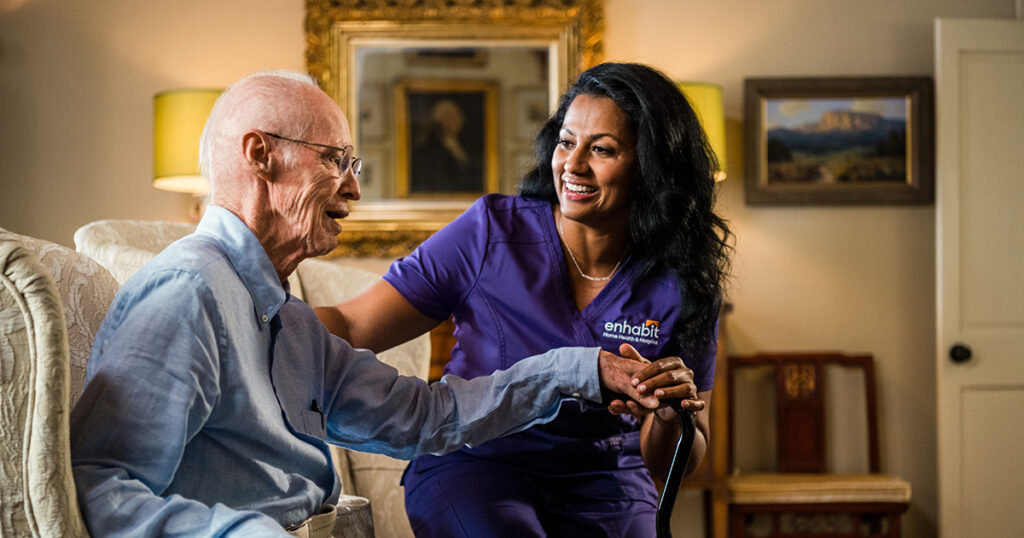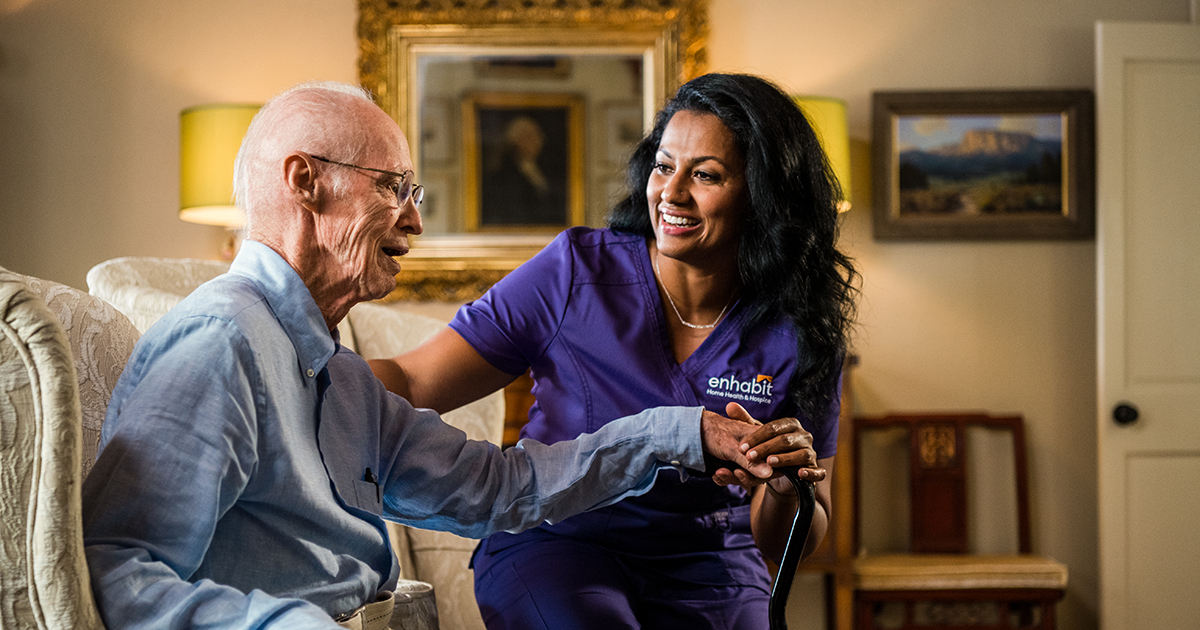Not every aging adult can live independently, resulting in many older adults moving into an assisted living facility to receive extra care to meet their needs. However, as the population is aging rapidly, the need for home-based care in assisted living facilities is growing as well.
According to the National Center for Assisted Living, there are around 28,900 assisted living facilities across the U.S., housing more than 900,000 residents. And nearly 75% are living with 2-3 chronic conditions, according the Centers for Disease Control and Prevention (CDC). This indicates there is an increasing need for additional, specialized care.
Utilizing a home health or hospice care agency is one way for assisted living facilities to fill in that gap.

The need for communication in assisted living facilities
Home health and hospice agencies provide care to patients wherever they call home, including assisted living facilities. Enhabit Home Health & Hospice has a specialized approach to treating residents in group settings: the Community Care Program.
“Enhabit’s Community Care Program started from identifying a need for our specific approach to care in assisted living facilities,” Vice President of Business Development Amanda Walker said. “We would hear from these communities that they were frustrated with the providers they were using for home health or hospice. They wanted and needed more communication from a clinical aspect. And our clinicians place communication at the top of their priority lists.”
Adding a home health agency into the scope of services can also keep assisted living facility residents happier and healthier, helping them remain in their community.
The interdisciplinary approach to each patient’s care plan ensures all needs are covered. Home health care provides skilled nursing and therapy, as well as medical social work and aide services. Additionally, home health can also help patients transition to hospice care if needed.
Home-based care and collaboration in assisted living facilities
Providing care in a community needs a different approach than providing care in the home. It requires an extra layer of collaboration between the home-based care team and the community.
“When we get a referral from a physician or hospital, we provide care directly in the patient’s home and then communicate with the caregiver and provide updates to their physician,” Walker said. “What sets our assisted living facilities apart is that the same people who provided the referral are seeing the care we are providing to the patient every day. This creates an expectation and requirement for collaboration.”
That expectation of collaboration is met through Enhabit’s Community Care Program.
The program focuses on continuity of care by having the same clinicians visit the same patients every day. This helps clinicians build close relationships and personal connections with their patients. That way, they can have a comprehensive view and provide the highest quality of care.
Additionally, they hold weekly meetings with the assisted living staff. In these meetings, staff discuss the patient’s goals, progress and any additional needs they might have. This serves as a way for everyone on the care team to contribute and stay updated on a patient’s plan of care.
“Our goal with the Community Care Program is to meet the health care needs of residents while allowing them to age in place,” Senior Vice President of Specialty Programs Kasi Hedt said. “We meet them where they are and help close gaps in care that could lead to a rehospitalization or transfer to a higher level of care.”
How home-based care can help assisted living residents
Most residents need help with some activities of daily living such as bathing, walking, dressing and going to the bathroom. However, many residents are also living with chronic conditions.
The National Center for Assisted Living recently identified the most common chronic conditions in assisted living residents:
- 55% have high blood pressure
- 20% have diabetes
- 34% have Alzheimer’s disease or dementia
- 34% have heart disease
- 27% have depression
As a home-based care provider, Enhabit places a large importance on patient education and self-management. If a patient better understands their condition and how to manage it, they will likely be more accepting of the guidance given to them. This makes them more likely to have a better patient experience, with better outcomes and a lower risk of hospitalization.
Enhabit’s Community Care Program also holds health education presentations that provide important information about common health conditions or issues. These presentations include facts about certain medical conditions, such as heart failure, and tips to help manage it.
“We focus on early intervention at Enhabit,” according to Hedt. “When a patient experiences a change in their condition, we are there to adjust and meet their health care needs. By being present in these communities with the same team of clinicians and health care educational offerings, we can better observe changes in condition. This allows us to proactively provide a better way to care for the residents in senior living communities.”
Increased connection with home-based care in assisted living facilities
While collaborative care builds stronger relationships with the community and home health or hospice provider, personal connections are also are formed between the home health or hospice clinician and the patient.
Having a consistent team of clinicians who see and treat a patient allows the patient to build a deeper trust with their care team. This continuity of care also gives home health clinicians extra insight into a patient’s progress. Then, they can make necessary adjustments to the plan of care to ensure the best outcomes.
Gretta’s story
Grace, a director of operations at Enhabit, had a patient named Gretta who resided in an assisted living community. Gretta, diagnosed with advanced dementia, began physical therapy services at Enhabit after falling multiple times. Her progressing dementia made it hard for Gretta to participate in her therapy visits at first.
Jamie, the physical therapy assistant on Gretta’s home health care team, took the time to understand her background. She painted a larger picture of who Gretta was before the dementia took over. Through spending time with her and creating a personal connection, Jaime found out that Gretta used to work as a dance teacher.
Knowing she connected so much with music, Jaime brought a speaker with him to their next session. Instead of his usual exercises, he developed a physical therapy plan that consisted of safe, easy dance moves. Suddenly, Gretta was excited to participate every day.
“I remember seeing Gretta and Jaime in the common area standing and swaying and dancing together, and it was the first time I saw joy in Gretta’s eyes in the many weeks I had cared for her,” Grace said. “It brought tears to my eyes! It’s a beautiful thing that we get to have the time with patients to know them as a whole person, not just the diagnosis that’s affecting them.”
Thanks to Jamie’s compassionate care and Enhabit’s Community Care Program, Gretta was able to spend her last months dancing again, just as she did as a young woman.
 Back to Resource library
Back to Resource library
Browse top categories
Social Share
At Enhabit our patients are our number one priority. From providing the latest medical practices to building deep personal connections, we’re focused on upholding every patient’s dignity, humanity and sense of control on their health care journey.
Home health
Our home health services give patients access to the care they deserve in the comfort of their own homes. From disease and injury management to recovery from surgery, our clinicians help patients confidently achieve their healthcare goals.
Hospice care
Our hospice care services place importance on the comfort of every patient living with a terminal illness. Our caring professionals are dedicated to providing not just physical care, but spiritual and emotional support to every patient and their loved ones.






